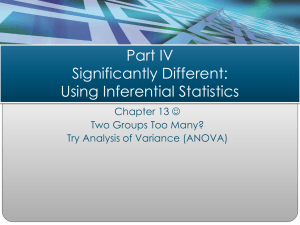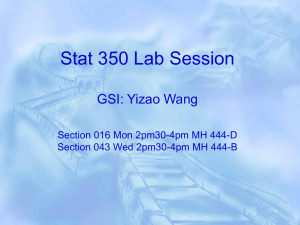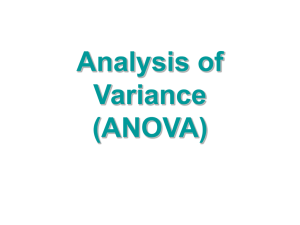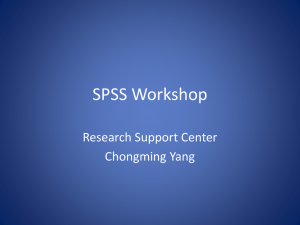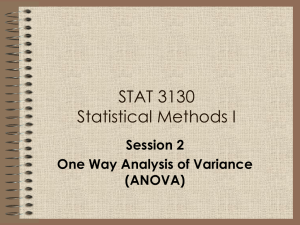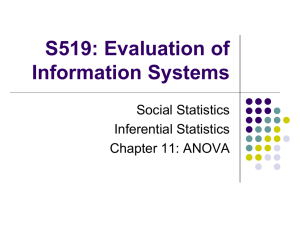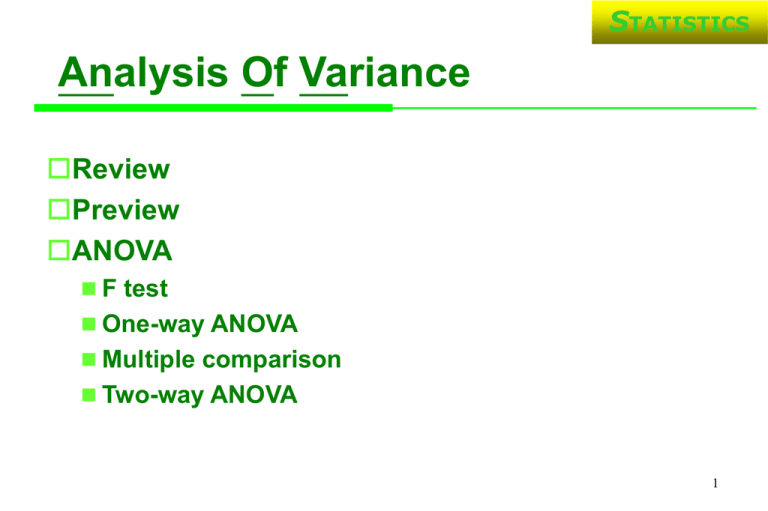
STATISTICS
Analysis Of Variance
Review
Preview
ANOVA
F test
One-way ANOVA
Multiple comparison
Two-way ANOVA
1
Review
STATISTICS
Standard normal distribution
Z value:
(Observed - Expected) in terms of UNITS of SD
x ~ N ( , 2 )
Z
x
x
2
Review
STATISTICS
Central Limit Theorem
For large n,
x ~ N ( , / n)
2
The beauty of CLT:
Easy to calculate V
The ugliness of CLT:
Hard to explain p
X N ( ,
x~
)
2
3
Review
STATISTICS
Sampling Distribution of
x1 ~ N (1, / n1 )
2
1
( x1 x2 )
x2 ~ N(2 , 22 / n2 )
1
2
x 1 x 2 ~ N ( 1 2 ,
( x x
1
12
n1
22
n2
)
(2x x
2)
1
1 2 x1 x 2
2)
4
Review
STATISTICS
Population & Sampling Distribution
Population parameters known
SD
Mean
x
x
i
N
x
xi
x
N
(x
Z score
i
)2
z
N
SEx
Population parameters unknown
n
Zx
X
( xi )
n
Please add yourself: ( x1 x2 )
Mean
x
x i
n
xi
x
n
SD
S
(x
SEx
t score
i
x) 2
n 1
S
n
t
tx
xx
S
( xi )
S
n
5
Review
Flowchart of 2G MD test
STATISTICS
1-s t
1 g ro u p
N > 30
1-s t
ND
1. Tra n s F fo r t
2. s ig n te s t
No o f g ro u p s
2-s t
2-s t
N > 30
Eq u a l va ria n c e
2-s t
Eq u a l N
ND
In d e p e n d e n t
2 g ro u p
1. tra n s fo rm fo r t
2. WRS te s t
1. Tra n s F fo r t
2. WRS te s t
P a ire d t
N > 30
P a ire d t
ND
If Ye s , g o u p ; If No , d o d o wn
1. tra n s fo rm fo r t
2. WS R te s t
STATISTICS
ANOVA
Analysis of Variance
7
ANOVA
STATISTICS
Analysis of Variance
The logic of ANOVA
Partition of sum of squares
F test
One way ANOVA
Multiple comparison
Two way ANOVA
Interaction and confounding
8
STATISTICS
ANOVA
Eyeball test for 3-sample means
1
2
3
1
2
3
Using 95% Confidence Limits
A: Non-Significant
B: Significant
Why?
Between group variation
Within group variation
Why not do 2-s test 3 times?
Alpha error inflated
Ex: 7 groups MD comparisons
1 / 21 < 0.05 !!
A
B
9
STATISTICS
ANOVA
Data sheet: k groups MD comparison
Subjects
Observed
1
X1
2
X2
3
X3
4
X4
5
X5
…
…
…
…
n
Xn
Tx
A
Group
Mean
Grand
Mean
Ma
Group
Effect
Ma-M
M
Total
Tx error
Difference
X1-Ma
X1-M
X2-Ma
X2-M
X3-Ma
X3-M
Mb-M
B
Mb
…
…
…
K
Mk
Mk-M
10
STATISTICS
ANOVA
The Logic of one-way ANOVA
Total Difference divided into two parts
(Observed-group mean)+(group mean-grand mean)
X ij X ( X ij X . j ) ( X . j X )
Total sum of squares divided into two parts
SS Total = SS Between + SS Within (or Error) SST =
( X
j
i
ij
SSB + SSE
X ) 2 [( X ij X . j ) ( X . j X )] 2 ( X ij X . j ) 2 ( X . j X ) 2
j
i
Partition of TD & TSS
Model of one-way ANOVA
X ij j eij
j
i
j
i
x
x
x
11
A
B
C
STATISTICS
Assumptions in ANOVA
Normal Distribution: Y values in each group
Not very important, esp. for large n
If not ND and small n: Kruskal-Wallis nonparametric
Equal variance: homogeneity
If not: data transformation or ask for help
Random & independent sample
12
ANOVA
STATISTICS
F test: variance ratio test
Review:
F test for equal variance in 2-s t test
F test: F=V1/V2
The larger V is divided by the smaller V
If two variances are about equal, the ratio is about 1
The critical value of F distribution depends on DFs
ANOVA for mean difference, k groups
Null hypothesis: 1= 2 = 3=…= k
Variance Between / Variance within
If F is about to 1, it’s meaningless for grouping
13
STATISTICS
ANOVA
F test : named after Fisher
Characteristics
a sickly, poor-eyesighted child
The teacher used no paper/pencil
to teach him
Very strong instinct on geometry
Mathematicians take years to prove
his formulas
Persistence
Calculation of ANOVA tables takes
Fisher 8 months, 8h/D to finish!!
Reference:
The lady tasting tea, Salsburg, 2001
「統計,改變了世界」天下,2001
Sir Ronald Aylmer Fisher 1890-1962
14
ANOVA
STATISTICS
One-way ANOVA
15
STATISTICS
ANOVA
One-way ANOVA table
Source of variation
SS
DF
Mean SS
F ratio
Between k groups
SSB
k-1
MSB
MSB/MSE
Error(within groups)
SSE
n-k
MSE
Total
SST
n-1
F test:
MS B MBSS SSB/(k 1)
F
MS E MESS SSE /(n k )
16
ANOVA
STATISTICS
Multiple Comparison
Definition:
Contrast btw 2 means: 1 2
More than 2 means is OK: [(1 2 )/2] c
Compare the overall effect of the drug with that of placebo
Contrast Coefficients: add to 0
Orthogonal
Two contrasts are orthogonal if they don’t use the same information
Ex: (1 2) and (3 4), i.e. the questions asked are INDEPENDENT
Types of MC: before or after ANOVA
Priori(planned) comparisons
post hoc(posteriori) comparisons
17
ANOVA
STATISTICS
Example 1: one-way ANOVA
Research problem:
Life events, depressive symptoms, and immune function. Irwin
M. Am J Psychiatry, 1987; 144:437-441
Subjects: women whose husbands
treated for lung Ca.
died of lung Ca. in the preceding 1-6 Months
were in good health
X: grouping by scores for major life events
Measurement: Social Readjustment Rating Scale score
Y: immune system function
NK cell activity: lytic units
18
STATISTICS
Printout
Box plot & Error bar plot
Error Bar Plot
Box Plot
60.0
100.00
54.4
48.9
CELL
75.00
43.3
37.8
50.00
32.2
26.7
25.00
21.1
15.6
10.0
0.00
1
2
3
1
2
3
GROUP
19
STATISTICS
Printout
ANOVA table
Analysis of Variance Table
Source Term
DF
Sum of Squares Mean Square F-Ratio
A: GROUP
2
4654.156
2327.078
S(A)
34
9479.396
278.8058
Total (Adjusted)
36
14133.55
Total
37
8.35
Prob
Power(Alpha=0.05)
0.001125* 0.947488
20
STATISTICS
Printout
Nonparametric ANOVA
Kruskal-Wallis One-Way ANOVA on Ranks Test Results
Method
Prob. Level Decision (0.05)
DF
Chi-Sq (H)
Not Corrected for Ties
2
11.16963
0.003754
Reject Ho
Corrected for Ties
2
11.17095
0.003752
Reject Ho
Group Detail
Group
Count
Sum of Ranks
Mean Rank
Z-Value
Median
1
13
351.00
27.00
3.3087
37
2
12
163.50
13.63
-2.0927
14.5
3
12
188.50
15.71
-1.2815
14.05
21
STATISTICS
ANOVA
MC: Priori comparisons
t test for orthogonal comparisons
t statistic: t
xi x j
2MS E / n
; not using SDp but MSE
DF: (n1+n2j); n=n1=n2
Adjusting downward: / (group number)
Ex: 4 comparisons, =0.05/4=0.0125
Bonferroni t procedure
Applicable for both orthogonal & non-orthogonal
t statistic:
Multiplier 2MSE / n
Multiplier table: no. of comparisons & DF for MSE
Able to find CI for mean difference
22
STATISTICS
ANOVA
MC: Posteriori comparisons
Tukey’s HSD (honestly significant difference)
MSE
HSD= Multiplier
n
Like Bonferroni, HSD multiplier table is needed (P176, table 7-7)
Able to find CI for mean difference
278.82
Ex: HSD 4.42
21.31
12
24.63
22.17
2.46
LOW
n=13
MOD
n=12
HIGH
n=12
23
STATISTICS
ANOVA
MC: Posteriori comparisons
Scheffé’s procedure
S statistic: S
( j 1) F ,df MS E
C 2j
nj
j: No. of groups; C: contrast; (alpha, df1, df2)=(0.01, 2, 34)
most versatile (not only pair-wise) & most conservative
EX: Low (Moderate & High) combined; Low Moderate
C 2j 12 (1) 2
12 (0.5) 2 (0.5) 2
0.125;
0.167
n j 12
12
12
n j 12 12
C 2j
S (3 1) 5.31 278.82 0.167 22.24
Note: MD btw L & H not significant
Able to find CI for mean difference
24
STATISTICS
ANOVA
MC: Posteriori comparisons
Newman-Keuls procedure
MS E
NK statistic: m ultiplier
2 Steps
2 Steps
n
3 Steps
Multiplier table is needed
Less conservative than Tukey’s HSD
Unable to find CI for mean difference
Ex:2 steps NK 3.87 4.82 18.65 ; 3 steps NK 4.42 4.82 21.31
same as HSD
25
ANOVA
STATISTICS
MC: Posteriori comparisons
Dunnett’s procedure
2MS E
Dunnett’s statistic: m ultiplier
n
Only used in several Tx means with single CTL mean
Relatively low critical value
Ex: D 2.71 6.82 18.48
2 units lower than HSD value;
4 units lower than Scheffé value
26
ANOVA
STATISTICS
Other posteriori comparisons
Duncan’s new multiple-range test
Same principle as NK test; but with smaller multiplier
Least significant difference, LSD
Use t distribution corresponding to the No. of DF for MSE
levels are inflated.
Proposed by Fisher
The above two procedures are NOT recommended by
statisticians for medical research.
27
ANOVA
STATISTICS
Summary of Multiple Comparisons
Don’t care about the formulas
Which procedure is better? depends on you!
Pairwise comparisons:
Tukey’s test: the first choice; Newman-Keuls test: second choice
Several Txs with single CTL:
Dunnett’s is the best
Non-pairwise comparisons:
Scheffé is the best
When larger than 0.05 is OK to you: e.x., drug screening
LSD, Duncan’s new multiple-range test are O.K.
The above two are not recommended by the authors
28
STATISTICS
Printout
Multiple comparisons
Newman-Keuls Multiple-Comparison Test
Group
Count
Mean
Different From Groups
2
12
15.60000
1
3
12
18.05833
1
1
13
40.23077
2, 3
Response: CELL; Term A: GROUP; DF=34; MSE=278.8058
Scheffe's Multiple-Comparison Test
Group
Count
Mean
Different From Groups
2
12
15.60000
1
3
12
18.05833
1
1
13
40.23077
2, 3
Critical Value=2.5596
29
ANOVA
STATISTICS
Two-way ANOVA
30
STATISTICS
ANOVA
The Logic of two-way ANOVA
SST divided into 3 or 4 parts
SST = SSR + SSC + SSE
SST = SSR + SSC + SS(RC) +SSE
Models of two-way ANOVA
Without interaction:
X ij i j eij
With interaction:
X ij i j (i j ) eij
31
STATISTICS
ANOVA
Simpson’s Paradox: 陳小姐買帽子
第一天
第二天
第一櫃(大人)
第二櫃(小孩)
兩櫃一起
紅色
黑色
紅色
黑色
紅色
黑色
合適
9
17
3
1
12
18
不合適
1
3
17
9
18
12
Total
10
20
20
10
30
30
90%
85%
15%
10%
40%
60%
32
STATISTICS
ANOVA
Statistical Interaction & confounding
Interaction: 2 lines with different slope
Y |T ,C 1T 2C 3TC
C0
H1 : ˆ3 0
Confounding: 2 parallel lines
C1
C1
Y
H1 : ˆ1|c ˆ1
How to test: ANOVA
C0
T0
T1
33
STATISTICS
ANOVA
Confounding factors
Mixing effect of X2 with X1 & Y
Definition:
Obesity
Associated With the disease of interest
in the absence of exposure
本身單獨與疾病有相關;本身是危險因子
Associated With the exposure
Cholesterol
MI
與危險因子有相關
Not as a result of being exposed.
干擾不能是中介變項:intervening variable
Intervening variable: X1X2Y
Example: S/S of diseases
34
ANOVA
STATISTICS
Interaction & confounding
Interaction:
The effect of X1 varies with the level of X2
A phenomenon you have to present
Main effects of X1, X2: not meaningful anymore
Ex: X1(Sex), X2(teaching method) & Y (language score)
Confounding:
Given condition: no interaction
A condition you have to control (or adjust)
35
STATISTICS
ANOVA
Two-way ANOVA table
Source of variation
SS
DF
Mean SS
F ratio
Among rows
SSR
r-1
MSR
MSR/MSE
Among columns
SSC
c-1
MSC
MSC/MSE
SS(RC)
(r-1)(c-1)
MS(RC)
MS(RC)/MSE
Error
SSE
rc(n-1)
MSE
Total
SST
n-1
Interaction
36
ANOVA
STATISTICS
Example 2: two-way ANOVA
Research problem:
Glucose tolerance, insulin secretion, insulin
sensitivity and glucose effectiveness in normal and
overweight hyperthyroid women. Gonzalo MA. Clin
Endocrinol, 1996;45:689-697
X1: BMI; X2: thyroid function
All categorical variables
BMI: 2 level; thyroid function: 2 level;
Y: Insulin sensitivity
Continuous variable
37
STATISTICS
Printout
Box plot & Error bar plot, ex 2
Means of IS
1.00
Error Bar Plot
1.0
HT
HT
0.9
0
1
0 Normal thyroid
1 Hyperthyroid
0.8
0.75
IS
IS
0.7
0.50
0.6
0.4
0.3
0.25
0.2
0.1
0.00
0.0
0
1
BMI2
0
1
BMI
38
STATISTICS
Printout
Descriptive statistics, ex 2
Means and Standard Errors of IS
Term
All
Count
Mean
SE
33
0.4647917
0
19
0.615
5.786324E-02
1
14
0.3145833
6.740864E-02
0
19
0.57375
5.786324E-02
1
14
0.3558333
6.740864E-02
0,0
11
0.68
0.0760472
0,1
8
0.55
8.917324E-02
1,0
8
0.4675
8.917324E-02
1,1
6
0.1616667
0.1029684
A: BMI2
B: HT
AB: BMI2,HT
39
STATISTICS
Printout
2-way ANOVA table, ex 2
Analysis of Variance Table for IS (alpha = 0.05)
Source
DF
SS
MSS
F-Ratio
Prob.
Power
A: BMI2
1
0.7112253
0.7112253
11.18
0.002293*
0.898154
B: HT
1
0.3742312
0.3742312
5.88
0.021745*
0.649738
AB
1
6.091182E-02 6.091182E-02
0.96
0.335909
0.157220
S
29
1.844833
Total (Adj.)
32
2.916255
Total
33
6.361494E-02
40
STATISTICS
Summary
Flowchart of 3G MD test
1 Fa c to r
O n e -wa y ANOVA
No . o f Fa c to rs
3 or more groups
ND
2 o r m o re Fa c to rs
Two -w a y ANOVA
o r o th e r
In d e p e d e n t
Kru s ka l-Wa llis
fo r 1 Fa c to r
Re p e a te d
ANOVA
ND
If Ye s , g o u p ; If No , d o d o wn
Frie d m a n
41
STATISTICS
QUIZ
Q: Can I use ANOVA to test 2G MD?
A: Yes, you can.
Q: What is the relationship btw ANOVA & 2-s t?
A: 2-s t test is a special case of ANOVA
F, t & Z table:
2
(1). F ,(1,n 1) t1 / 2,( n 1)
2
2
(2).df2 , F ,(1,) Z12 / 2
42
STATISTICS
Home Work
Chapter 7, exercise 7, (table 7-20, p187)
Analysis of phenotypic variation in psoriasis as a function of age at onset and family
history. Arch. Dermatol. Res. 2002;294:207-213
Answering the following questions:
Is there a difference in %TBSA (percent of total body surface area affected) related to age at onset?
Is there a difference in %TBSA related to type of psoriasis (familial vs. sporadic)?
Is the interaction significant?
What is your conclusion?
43

